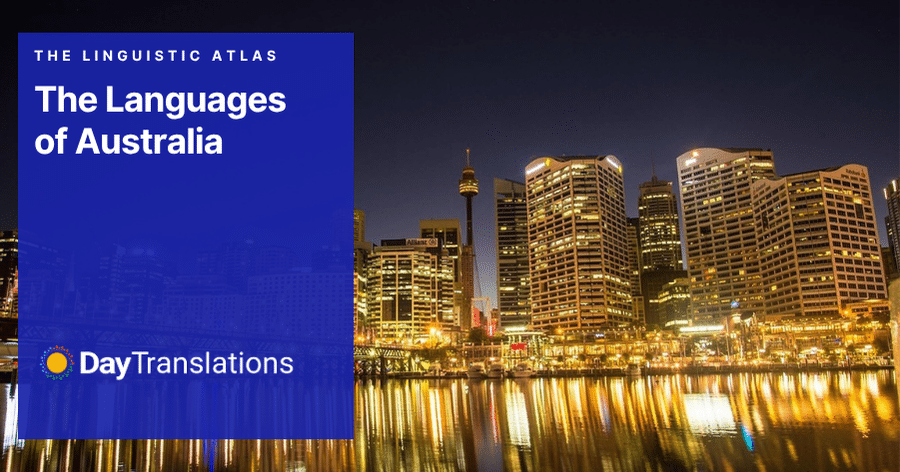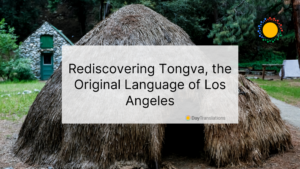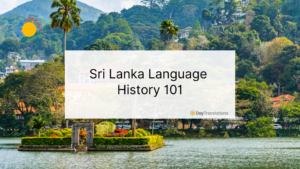Australia is the sixth-largest country in the world, so it would be logical that Down Under is among the most populous countries in the world. However, mostly due to harsh geographical and climate conditions in the outback, the total population of Australia barely exceeds 27 million people. What’s surprising is that the number of languages of Australia is as high as in some much populous countries. Although there’s no single official language of Australia, English is the main language for the vast majority of Australians. There are numerous Aboriginal languages, plus various immigrant groups have brought their mother tongues with them.
Official Languages of Australia
In spite of the existence of more than 220 indigenous languages of Australia, none of them is the official Australian language. Even Australian English, which is the lingua franca of the present-day Australian language ecosystem, isn’t the official language of Australia. In addition to Australian English and the Aboriginal languages, every group of immigrants has brought their own language and customs.
Aboriginal Languages in Australia
At the time when James Cook claimed Australia for the British Crown in 1770, there were between 250 and 260 Aboriginal languages in Australia. According to scientists, those were actively spoken languages. In addition to this number, there were allegedly more than 800 dialects spoken across the continent at that time. The entire area of Australia and Oceania is a lush linguistic ecosystem, with Papua New Guinea as the world record holder: more than 830 languages are still spoken in this country.
Before the British colonisation of the 18th and 19th centuries, Aboriginal people and languages had been present on the territory of Australia for more than 65,000 years. Unfortunately, the colonial period was marked by segregation and misunderstanding of the customs and the indigenous languages of Australia. The present-day cultural, political, and linguistic public in Australia nurtures a unique kind of care and pays special attention to the remaining Aboriginal languages in Australia.
These are scattered across the country, with most of them being used by a few hundred or several thousand speakers. For instance, even the most widespread Australian languages, like Torres Strait Creole (aka Yumplatok) or Kriol, or Djambarrapuyngu, are spoken by 7,500, 7,400, and 3,800 speakers, respectively.
Some 3,400 speakers use the Pitjantjatjara language, while Warlpiri is spoken by some 2,590 speakers, Murrinh Patha by 2,060 speakers, and a bit more than 2,050 speakers use the Tiwi Aboriginal language.
Aboriginal Languages per States and Territories
The proof of how much the modern Australian state looks after the indigenous languages of Australia is the detailed classification of the remaining speakers of those languages and dialects.
When it comes to the territorial distribution, the Northern Territory is home to the largest number of Aboriginal languages. To be more precise, local people speak 19 indigenous languages, which amounts to a total of 28,100 speakers.
Western Australia comes second, with 17 domestic languages, spoken by a bit more than 8,000 people.
There are five Aboriginal languages in Queensland, with around 1,800 speakers, while South Australia hosts four languages, but with a bit more speakers – 3,900.
In New South Wales, the Australia language authorities nurture three domestic languages, with some 600 speakers. What’s more, some of those 260 languages and 800 dialects are spoken by as few as 10 speakers.
An interesting trivia – at least interesting to linguistics aficionados – is the fact that the traditional customs spread among the Aborigins include a changed use of language. For instance, when a certain indigenous community mourns after a funeral or is getting ready to initiate some members through a rite of passage, they use restricted language. That’s why there are also various sign languages used by the Australian Aborigins. Also, in some social occasions, people use a sort of coded speech, known only to members of a certain family or a closer community.
The Immigrant Languages of Australia
The Aboriginal languages aren’t the only non-English languages used in Australia. Several waves of immigration have also helped shape the languages of Australia.
After the Second World War, Australia became a promised land for European immigrants. The economy was growing, and there was a lot of free space where people could afford to buy a patch of land or a place of their own. During that immigration wave, it was mostly Italians and Greeks, but also Hungarians, Romanians, and Germans who came to live in Australia. Those languages gradually became important in the Australia language community. Nevertheless, the highest number of immigrants moved from the UK and Ireland to Australia in the period 1945-1980. However, those migrations aren’t too interesting from a linguistic point of view, since British English was predominantly their mother tongue.
The New Immigrant Languages
In the last thirty years, Australia has kept receiving a significant portion of immigrants originating from Europe. However, there’s been a major surge in the number of immigrants from Asian countries. As a result, Mandarin, Vietnamese, Arabic, Punjabi, and Hindi have become important languages in the language stage Down Under. As a matter of fact, in 2021, 5.8 million people living in Australia reportedly used a language that’s not English (Australian English or any other variation of English) at home. Based on the predictions for the future, the Mandarin language, spoken mostly by Chinese Immigrants, is highly likely to remain the second most spoken language, after English. In 2021, more than 600.000 people spoke Mandarin at home, followed by 367.000 Arabic speakers, and 320.000 Vietnamese.
Languages in Australia in a Nutshell
The Australian linguistic framework is changing under the global changes. As more people are moving to this country, they’re bringing their linguistic and cultural customs. From this point of view, we can expect a more intensive growth in the use of languages originating from Asian countries. The general consensus is that the Aboriginal languages remain as protected as possible, even if only one person speaks it. Australian English will remain the predominant language in everyday communication, public administration, and education. Still, newer generations are more interested in learning foreign languages while getting familiar with the indigenous languages of Australia. All these trends will contribute to drawing an even more colourful language image Down Under.
Languages of Australia: Day Translations Can Help
Day Translations delivers expert translation services, on-demand interpreting, and culturally precise localization services tailored to Australia’s diverse linguistic landscape. Partner with us to communicate clearly and respectfully across regions and industries. Get a free quote now!












Sorry, the comment form is closed at this time.